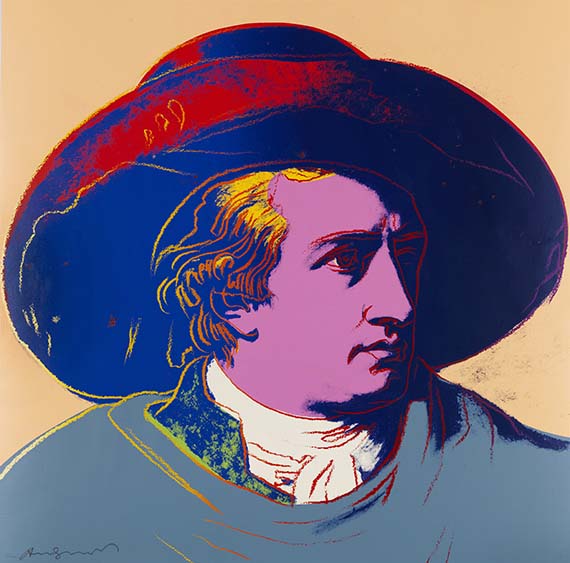Asta: 530 / Evening Sale / The Hermann Gerlinger Collection del 10 giugno 2022 a Monaco di Baviera  Lot 94
Lot 94
 Lot 94
Lot 94
94
Andy Warhol
Goethe, 1982.
Silkscreen in colors
Stima:
€ 180,000 / $ 198,000 Risultato:
€ 745,000 / $ 819,500 ( commissione inclusa)
Goethe. 1982.
Silkscreen in colors.
Feldmann/Schellmann/Defendi II.270-273. Signed and numbered. From an edition of 100 copies. On Lenox museum board. 96.3 x 96.3 cm (37.9 x 37.9 in), the full sheet.
The complete set. Printed by Rupert Jasen Smith, New York (with the blindstamp). Published by Schellmann & Klüser, Munich/New York, in cooperation with Denise René/Hans Mayer, Düsseldorf (with the copyright stamp on the reverse).
• Very rare as complete series and matching set.
• An icon of world literature portrayed by Warhol.
• Tischbein as a cult motif of Pop-Art.
PROVENANCE:
Galerie Hans Mayer, Düsseldorf.
Private collection (acquired from the above in 1993).
LITERATURE:
Forty are better than one. Edition Schellmann 1969-2009, published by Jörg Schellmann, Ostfildern 2009, pp. 342-343.
Silkscreen in colors.
Feldmann/Schellmann/Defendi II.270-273. Signed and numbered. From an edition of 100 copies. On Lenox museum board. 96.3 x 96.3 cm (37.9 x 37.9 in), the full sheet.
The complete set. Printed by Rupert Jasen Smith, New York (with the blindstamp). Published by Schellmann & Klüser, Munich/New York, in cooperation with Denise René/Hans Mayer, Düsseldorf (with the copyright stamp on the reverse).
• Very rare as complete series and matching set.
• An icon of world literature portrayed by Warhol.
• Tischbein as a cult motif of Pop-Art.
PROVENANCE:
Galerie Hans Mayer, Düsseldorf.
Private collection (acquired from the above in 1993).
LITERATURE:
Forty are better than one. Edition Schellmann 1969-2009, published by Jörg Schellmann, Ostfildern 2009, pp. 342-343.
The "Goethe" series of portraits can be recognized as a work by the pop art icon Andy Warhol at first sight. In silk-screen printing he found the medium with which his visual language can be implemented best. And this despite the fact that silk-screen printing as an artistic medium is just as far from the spontaneous painting gesture as serial production is from the original, individual artwork. With Warhol, however, the poignancy of a motif lies precisely and only in the sum of the images. Warhol legitimized the screen printing process, which had previously been used primarily for commercial purposes, as an equal means of design in fine arts. Working from templates became his stylistic device, he alienates a well-known motif through the use of trendy colors and bold flattening. He adds graphic elements to the screen printing process, which expands the motif with a painterly surface structure and the unmistakable artistic signature. This is how Andy Warhol developed his striking, unmistakable visual language. As in many other works, the underlying design principle of the "Goethe" suite is the variation of the same iconographic theme. From 1962, Warhol portrayed celebrities such as Marylin Monroe and Elvis Presley in his unmistakable style, using press photos as his template. Since Goethe died in 1832, Warhol naturally could not use a photo for this portrait. And he certainly couldn't put the poet in a photo booth or take a Polaroid like he did with so many of his subjects. When the portrait work of Johann Wolfgang von Goethe was created, Warhol had already been creating images of the icons of his own time for almost two decades. However, in the late 1970s and early 1980s, he found several new sources of inspiration. From this point on, Warhol increasingly turned to older icons. These are not just people, but also works by the Old Masters and other cultural landmarks. In this sense, his portrait of Goethe ranks alongside the Mona Lisa and the Last Supper, as well as Lenin and Beethoven. The publisher Siegfried Unseld inspired him to create the Goethe portrait, and he took the pop artist to Frankfurt in 1980. The Städel probably has the best-known and most widespread portrait of Goethe by Johann Heinrich Wilhelm Tischbein. The painting entitled "Goethe in the Roman Campagna" was created around 1786/87. Warhol isolated a section of the painting and turned it into a Pop art portrait. Due to the distinctive hat, it is immediately recognizable which painting Warhol used as template. Warhol, already an icon himself, elevates the already famous template with his artistic signature and takes it into the present. He refreshes the myth of "Goethe" by placing his filter over a portrait that has been around for centuries, thus creating a trendy portrait of Goethe for the modern age. [SM]
94
Andy Warhol
Goethe, 1982.
Silkscreen in colors
Stima:
€ 180,000 / $ 198,000 Risultato:
€ 745,000 / $ 819,500 ( commissione inclusa)





